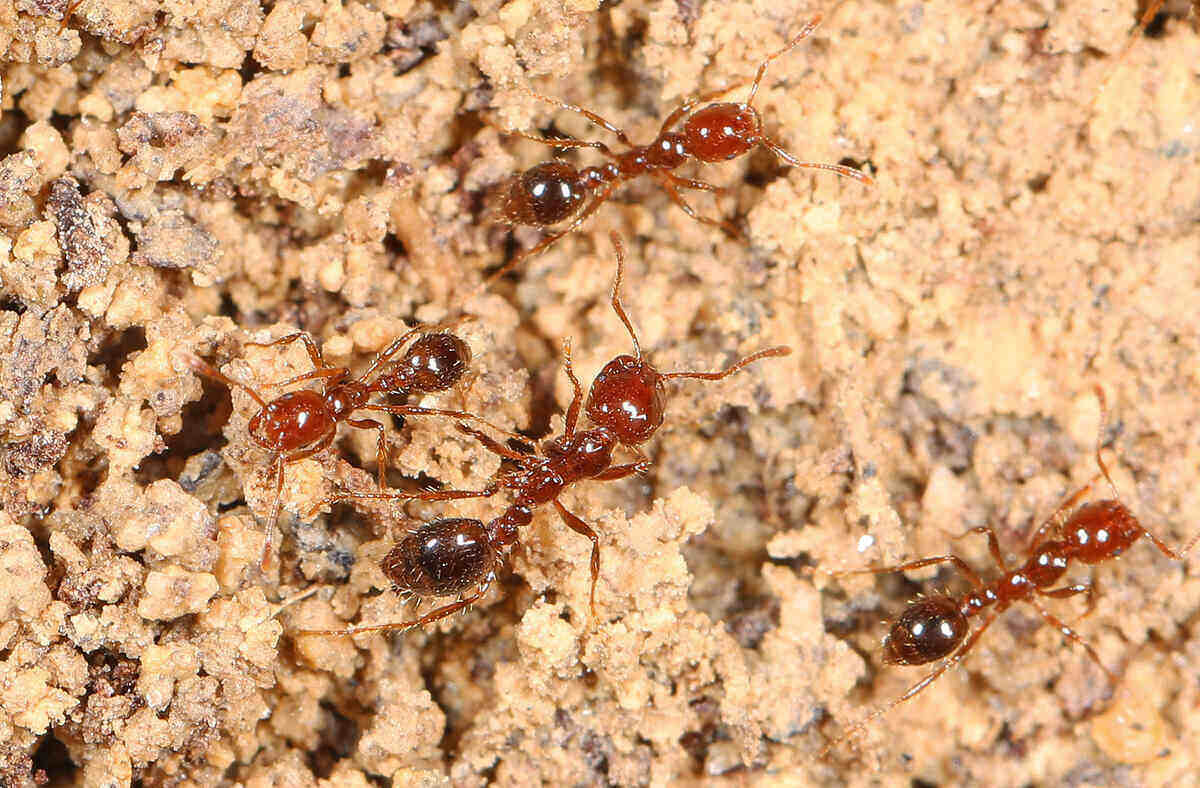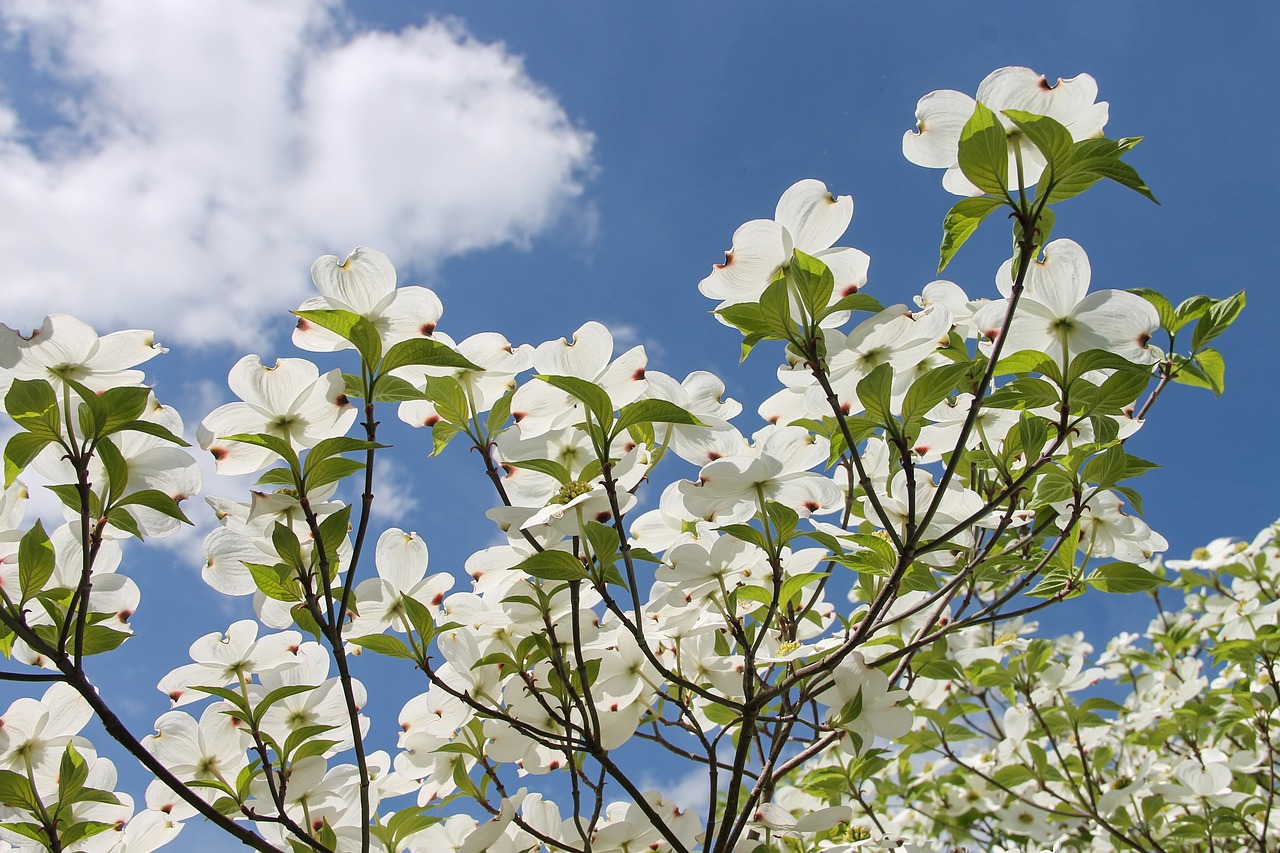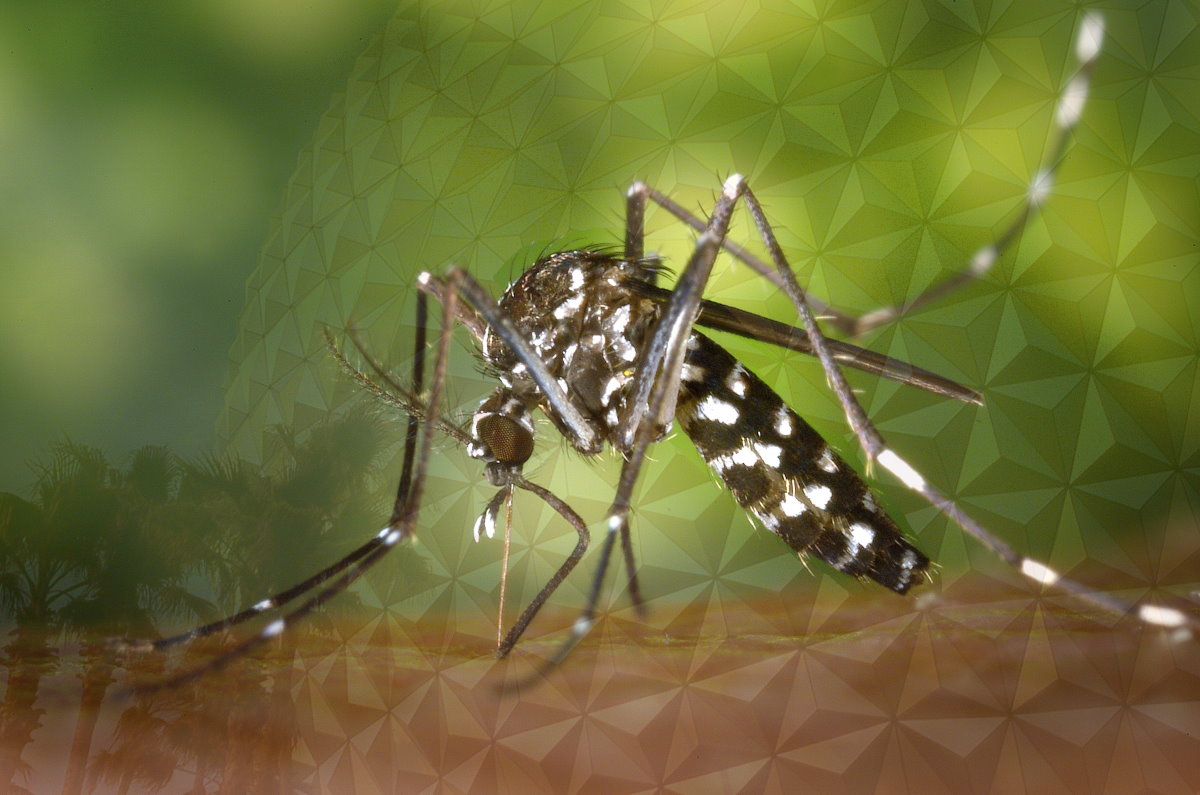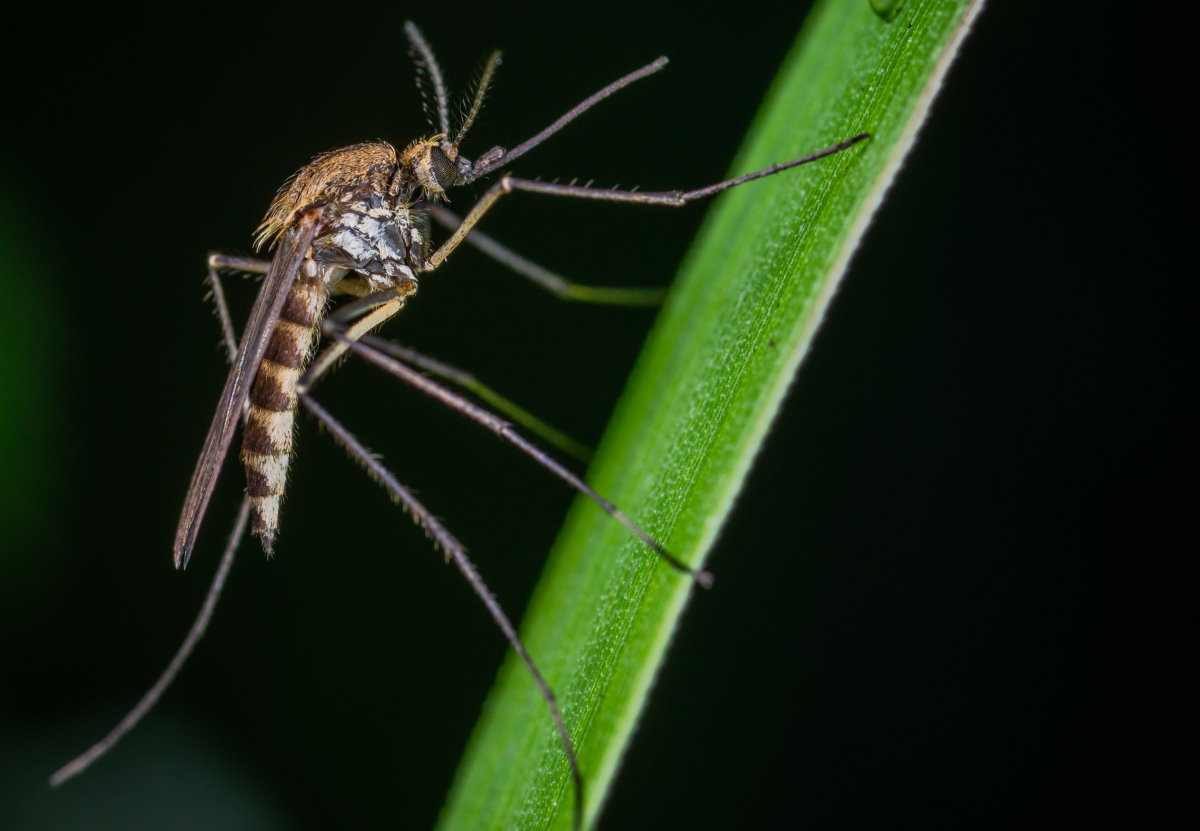
If you could change one thing about Orlando, what might it be? Traffic, humidity … what about insect bites? Orlando has several creepy critters that bite and sting. Even though most of these want nothing to do with you, it’s good to be in the know about these bugs that bite and sting in Orlando.
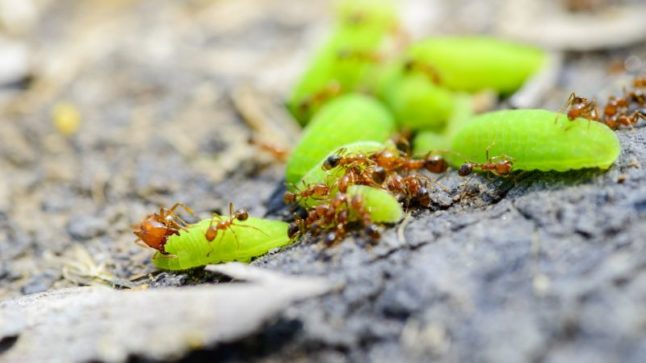
Photo Credit: NguyenBinh735 / Pixabay
Fire Ants
If you’ve been bitten by an ant in Orlando, it may have been a fire ant. There are two common types of fire ants in Florida:
- Imported fire ant (Solenopsis invicta)
- Native fire ant (Solenopsis geminata)
These two species of fire ants look almost identical: Both species have a red-brown coloring and are 3 to 6 millimeters long, but the native fire ant coloring may deepen to black. Another, though less noticeable difference is that the imported fire ant has four teeth, while the native fire ant has no teeth. (If only we could put on an ant suit and shrink down to their level…)
Both of these fire ants may sting, but the imported fire ant sting causes a white pustule or blister to form on one’s skin; the native fire ant sting does not cause a pustule to form.
Fire ants usually nest in visible mounds of dirt, but they can create a habitat in other places, too:
- Inside one’s home
- Inside decaying logs
- Near stumps or trees
- Beneath buildings or pavement
- Within electrical systems, which may cause a short in the circuits
How to Control Fire Ants
Fire ants are known to attack anything that disturbs or steps on their nest with a painful bite. It is very important to 1) identify the ant and 2) to find the mound (where the rest of the ants live) to manage the problem effectively. Also, know that keeping your property fire ant-free is more of a maintenance task than a once-and-for-all endeavor. Expect to re-treat as often as once per month.
No fire ant control method is permanent, but here are a few ways to help get rid of fire ants on your property:
- Set out bait around the mounds and in the landscape where they travel when you have a few dry days (per the label)
- Pour boiling water over the mounds
- Consider this mound-destroying mixture from a Florida farmer, a natural way to get rid of fire ants: Fill a 5-gallon bucket with water, one-third cup of commercial grade d-Limonene, and a large squirt of natural dish soap. Pour on the mounds early in the morning.
Tips on technique: Pour from the outside in a spiral, and go slowly to minimize runoff. Finally, treating early in the morning is key. Queens are higher up in the mound, and the ants don’t move as quickly.
To prevent fire ants in the home (assuming you’ve already had a pest control pro knock out an existing problem), use weather stripping around windows and doors, and apply silicone caulk around the inside and outside areas of the home (around plumbing, baseboards, cupboards, and outlets). Keep yard debris away from the home to prevent nesting sites, and keep the inside of the home free from spills and unsealed leftovers.
If this sounds like a job for a pro, contact an Orlando pest control professional to take this worry off your feet and your mind.
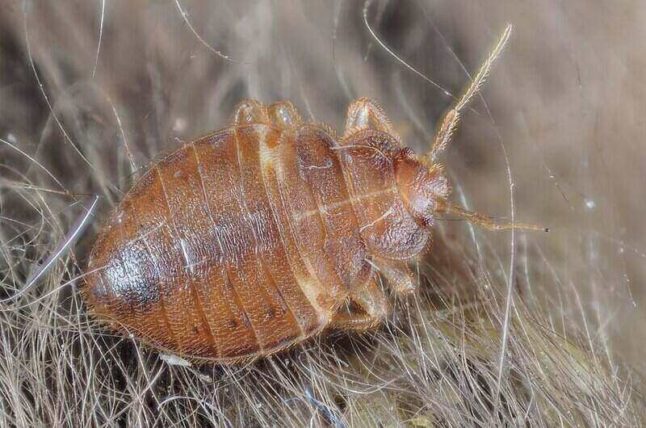
Photo credit: Gilles San Martin / Wikimedia Commons / CC BY-SA 2.0
Bed Bugs
In 2022, Orlando came in as the 46th worst city in the U.S. for bed bugs according to Orkin’s annual list. Although bed bug populations were virtually nonexistent after WWII with the advent of (now-banned) pesticides such as DDT, populations have been surging lately. Bed bugs often travel from one place to another on luggage and clothing, so the hospitality industry has borne much of the brunt of this problem.
Bed bugs are small insects that rely on blood meals to survive. The nymphs (baby bed bugs) start as small as a pencil point and are clear to tan-colored. The adults grow up to 9mm in size (before their blood feast) and range from red to brown and live about one year. Females lay up to five eggs each day, growing the population quickly.
Bed bugs are often found in a few common places inside homes:
- Crevices and cracks (furniture, beds, mattresses, and walls are common)
- Behind wood panels and wallpaper
- Beneath carpet
How to Control Bed Bugs
Bed bug control is a professional job, so contact an Orlando pest control company. Don’t try to DIY this issue. Here are some of the methods a pest pro will consider:
- Chemical strategies: Insecticides and fumigation
- Non-chemical strategies: Hand removal, sealing off an area or item (mattress, for example), heat treatment, sealing cracks and crevices, and vacuuming
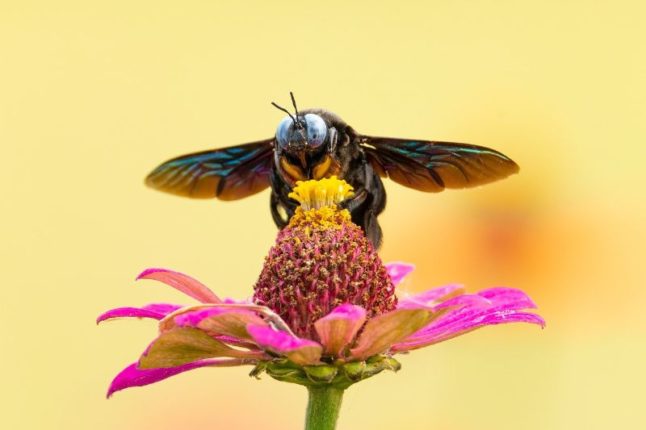
Photo Credit: phichaklim1 / Pixabay
Bees and Yellow Jackets
Bees: Florida is home to more than 320 species of bees. We’ll only highlight two here.
- Bumble bees are social creatures that create new colonies each spring. Like 70% of all bees, they nest in the ground. They prefer to use ground cavities such as old rodent burrows to build their colonies each year. Bumble bees in Florida do sting, so keep your distance.
- Honey bees live above-ground in tree cavities or other places where they are sheltered from predators. These bees may be known for their honey, but they also sting. The good news is that they only sting once.
In the spring, bees may swarm (leave an old nest to form a new colony). If you see a large mass of bees on your trees or fence line, don’t worry. Most bees will move to a new location in a few days, or even as quickly as a few hours. However, if they find their way into a house or onto the eaves, you’ll need to take action to have them removed.
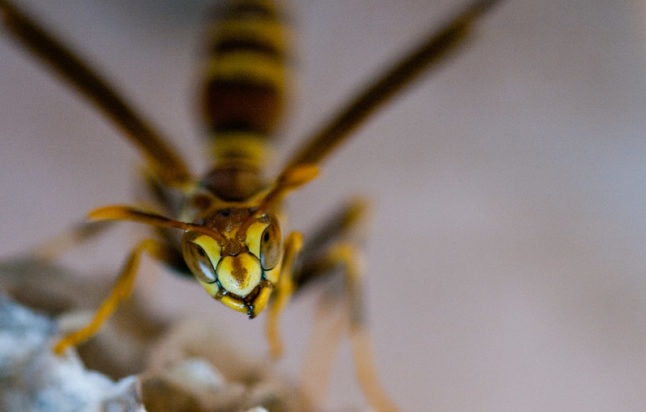
Photo Credit: greg westfall / Flickr / CC BY-SA 2.0
Yellow Jackets: Like bumble bees, yellow jacket colonies die out each year, except for the queens. In spring, the queens emerge from their winter hibernation and start the colony anew.
Unlike honey bees, wasps may sting multiple times and are infamous for being aggressive. If one yellow jacket is hurt, it sends out an alarm pheromone, which brings out the whole colony to attack and defend the nest.
How to Control Bees and Yellow Jackets
Bees and yellow jackets are essential and extremely beneficial to local ecosystems. However, if a yellow jacket nest, underground bee nest, or swarm of bees (sometimes called a feral colony) is too close to your home, call an Orlando pest control pro or registered beekeeper to discuss control options.
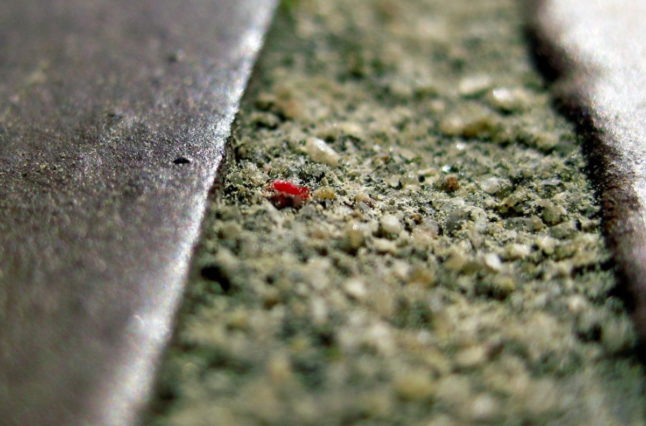
Photo Credit: Scott Akerman / Flickr / CC BY-SA 2.0
Chiggers
Chiggers represent the larval stage of mites in the family Trombiculidae. It is in this larval (immature) stage that these mites, also called red bugs, feed on amphibians, birds, mammals, and reptiles. Believe it or not, humans are considered an “accidental host” since humans don’t provide adequate nutrition for the larvae. Other species are preferred as they provide a more balanced meal.
Chigger bites cause welts that appear from four to eight hours after the first bite. These tiny larvae inject an enzyme that dissolves skin cells. Then, they nourish themselves by sucking up this liquid tissue meal. Chiggers are unlike mosquitoes, bed bugs, and other pests in that they do not remove blood from their host.
Chiggers usually survive on humans for one to three days, although some die in as little as a few hours. If the larvae stay on for longer than a few hours and the skin starts to swell, it may appear that the chigger has burrowed itself into your skin; however, this is not the behavior of this pest. It is that the skin has swollen and enveloped the chigger, not the other way around.
Fun Fact: Chiggers are not an insect but are part of the class Arachnida. (Think spider and tick family.)
How to Control Chiggers
No one wants any pest to feed off of their skin cells, right? Here are a few ways to enjoy the outdoors without any post-hike itch:
- Dress like you’re going on a hike: Wear long pants and sleeves, sturdy shoes, and tuck pants into shoes
- Consider using insect repellent with DEET
- Exclude chigger hosts from your property, namely amphibians, reptiles, rodents, and other small mammals
- Mow the grass on the short side and keep shrubs trimmed and neat. A shorter lawn means higher soil temps and less humidity, which makes the space less of a chigger hot spot.
Pro Tip: To check for chiggers in your lawn, paint a piece of cardboard black. Then, stand it up in the lawn. Any chiggers in the area will make their way to the top. If you see very small pink or yellow moving dots along the cardboard, you’ve got chiggers.
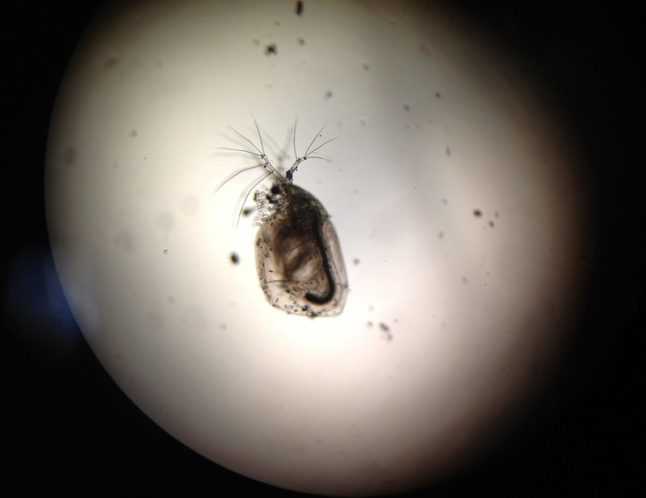
Photo credit: Pommiebastards / Flickr / CC BY-SA 2.0
Fleas
If your furry friends start to scratch or bite incessantly, watch out: You may have fleas. Fido and Kitty aren’t the only ones who may start to scratch: Other animals, including chickens, rodents, squirrels, and humans may be the next target for these pests.
Fleas have four life stages: Egg, larvae, pupae, and adult. If your pet has brought fleas indoors, you’ll need to address each life stage to get rid of this itchy pest.
How to Control Fleas
If you have a bad infestation of fleas in your home, treat three subjects: The pet, the home, and the lawn. If your flea fiasco isn’t that bad, you may not need to treat the lawn.
Treat the pet:
- Use any shampoo or mild detergent to wash your pet. The water drowns and/or dessicates adult fleas. When you scrub your pet’s skin, you remove flaky skin and dried blood, as well, which provide food for flea larvae.
- Or, use a dust first, and then bathe the pet to prevent Fido from ingesting the dust product.
- Comb your pet. This reduces fleas by 10-60%.
- Use topical or oral treatments, as directed by your vet.
Treat the home:
- Wash pet bedding every week.
- Vacuum. This will remove all stages of flea except the pupae, which become stuck to carpet fibers. Steam vacuums usually perform better than standard vacuum cleaners.
- Consider products such as boric acid or linalool. Synthetic chemical products are also available to spread or spray on carpet and upholstery.
Treat the lawn:
- Yard sprays and insect growth regulators (IGRs) are helpful. IGRs ensure larvae will not develop into adults and can last for up to three months. Use these products only in the areas where your pet spends most of its time. There is no need to treat the whole yard. Also treat shady, dry areas, or water the yard to drown them instead.
- Steinernema carpocapsae nematodes are another yard treatment option. There is not enough research to determine their efficacy, but there are many anecdotal reports of success with them. In addition, many universities consider beneficial nematodes a worthwhile addition to your biological control toolbelt.
Some research shows that nematodes work well in sandy soil. Water the lawn before and after you apply the nematodes with ¼ to ½ inches of water.
Pro Tip: Treat the home and your pet (and the lawn, if applicable) at the same time. Some products require retreatment in two to four weeks to kill fleas at all stages of life.
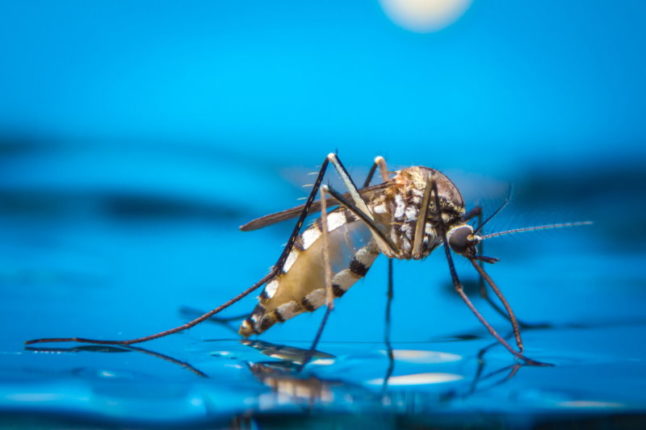
Photo Credit: Shutterstok
Mosquitoes
Mosquitoes are the bane of backyard get-togethers, and outdoor life in general, in Orlando. From April through October, Orlando residents must be on alert to keep their yards free from this common Florida pest to prevent bug bites and general misery throughout the summer.
According to the University of Florida, there are over 80 species of mosquitoes in this state. So, there are sure to be a few (or a few thousand) hanging out in your yard throughout the breeding season. Some mosquitoes are merely nuisance insects, while others spread harmful diseases, including dog heartworm and Zika and West Nile viruses.
How to Control Mosquitoes
Thankfully, there are not 80 ways to control these biting pests. The advice for controlling most mosquito species focuses on a few areas:
- Empty standing water sources to prevent large numbers of baby mosquitoes from hatching. Many species of mosquito lay their eggs in standing or still water. Eliminate water from buckets, tires, plant saucers, and water-holding plants (bamboo and bromeliads).
- Clean up the debris. Mow, cut, and prune overgrown vegetation, tall grass, leaves, and weeds. Clear out fallen branches, and move lawn furniture and toys, as well. If you decide to use a lawn treatment, this will open up the area so the treatment doesn’t miss any shady spots.
- Use a larvicide for uncovered containers that you can’t empty every few days, such as water-holding plants, open rain barrels, or drainage ditches that hold some water most of the time.
- Adulticides work as a last option. Even organic sprays should be a last resort (after you’ve tried the methods listed above). Refrain from spraying during the day when pollinators are most active, and avoid getting the product on flowers. Even residual amounts of pesticides can kill or harm beneficial insects, so use these products with care.
If you’ll be outside during dawn or dusk, when mosquitoes are most active, consider an insect repellent and long pants and sleeves as extra protection against those itchy mosquito bites.
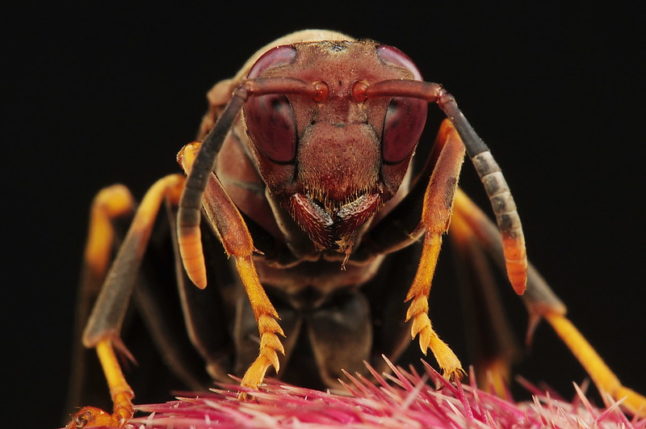
Photo credit: Mike Keeling / Flickr / CC BY-SA 2.0
Paper Wasps
If you’ve ever seen a papery nest under the eaves of your home, you may be looking at the home of a paper wasp. Paper wasps have brownish-red bodies and two large, dark brown to black wings. Unlike yellow jackets, paper wasps are not known to be aggressive but will sting if threatened.
Paper wasps often build their papery nests on residential homes, under eaves, and in tree cavities. The cells are hexagonal and made from saliva and wood tissue.
How to Control Paper Wasps
Do you really want to get rid of paper wasps? If you have a garden, you might want these stingers around. Paper wasps are considered a beneficial insect because they help pollinate crops as they collect nectar. Not only that, but they also feed on farm pests, such as beetle larvae, caterpillars, and cicadas.
If you’re not interested in keeping paper wasps around the house, they’re not too hard to remove:
- Wait until evening when they are inactive.
- If it’s a small nest, use a broom to knock it down.
- If it’s a larger nest, consider a commercial aerosol insecticide (follow label instructions).
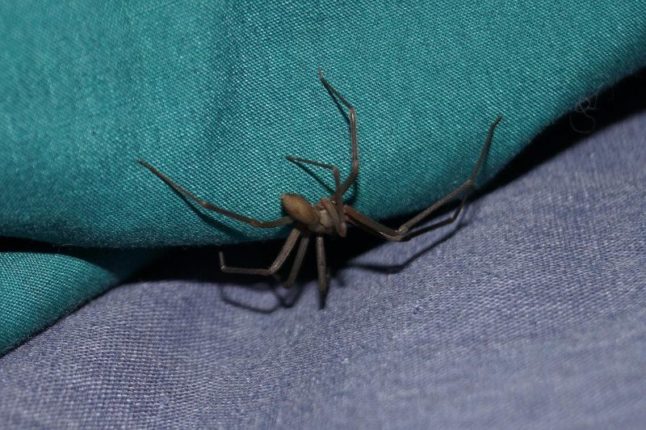
Photo Credit: rlockeby / Pixabay
Spiders
First off: Spiders are not insects. They belong to the class Arachnida, but we’ll consider them here as friends of a different feather if you will.
If you’re concerned about spider bites, here’s some reassuring news: Although all spiders have fangs, only a small percentage of those fangs can pierce skin and inject venom. Among that small group, an even smaller few spiders possess venom that is harmful or life-threatening to humans. To boot, spiders are incredibly shy and want nothing to do with you.
How to Control Spiders
Whether you’re likely to get bitten or not, you probably don’t want these eight-legged creatures in your home or outdoors close to the house. Here are a few tips to get rid of spiders inside and out:
- Get rid of bugs inside your home. Spiders are an important means of keeping insect populations down. If you don’t have any tasty snacks waiting inside your home, they’ll have no reason to visit.
- Keep your home and lawn clean and tidy with no clutter.
- Turn off your outdoor lights at night. Lights attract insects, which means spiders will congregate underneath eaves and around your home near these lights.
- Spiders breed near piles of bricks, lumber, trash, and structures such as sheds, so get rid of these.
- Vacuum spider sacs as you see them. Empty the bag or canister outside the house.
- Chemicals are best left to the professionals. Dusts can be effective in utility spaces, attics, and crawlspaces. Sprays are tricky in enclosed areas and may be best left for a pro.
Pro Tip: If you are bitten by a spider you think may be venomous, such as a black widow spider, collect the spider in a container if you can, and seek medical attention right away. An accurate diagnosis will provide the best treatment, if needed, for your bite.
It may also calm you to know that there are no known wild breeding populations of the venomous brown recluse spider in Florida. Most known sightings have been of recluses transported from other states via shipping containers, cars, and the like.
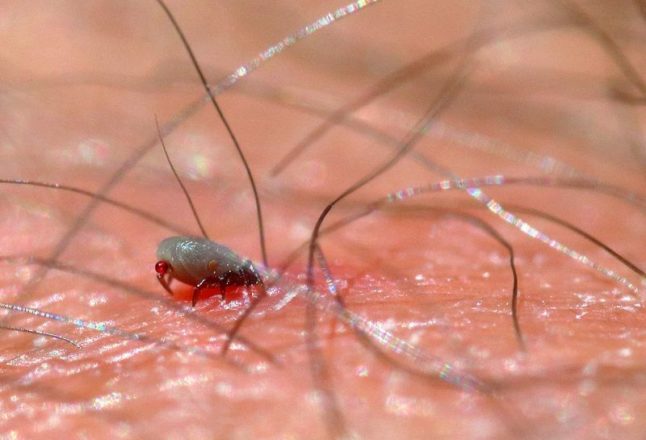
Photo Credit: Dunpharlain / Wikimedia Commons / CC BY-SA 4.0
Ticks
Would you believe that ticks are arachnids? That’s correct. Ticks have eight legs and are more closely related to spiders and mites than insects. Like spiders, though, we’ll consider them on this “bug” list since you don’t want them in your home or jumping on you in the lawn.
These are five common tick species you may encounter in Florida:
- American dog tick
- Black legged tick (aka deer tick)
- Brown dog tick
- Gulf Coast tick
- Lone Star tick
The tick life cycle consists of four stages: egg, larva, nymph, and adult. The nymphs are particularly small and may go undetected on a host, so prevention is key. Wear long pants, and tuck them into your boots. Tuck shirts in as well.
Finally, consider an EPA-approved repellent for an additional layer of protection. Learn more about EPA-approved active ingredients, including DEET and oil of lemon eucalyptus, to make the best decision for your family.
How to Control Ticks
In addition to sucking the blood from a host, ticks can transmit disease. To avoid providing lunch for these tiny arachnids, here are a few ways to control ticks in your Orlando lawn:
- Keep the area next to your home and at the lawn’s edge free from brush and tall grass.
- Keep wild animals off your property. Rodents, racoons, deer, skunks, and other wildlife carry the ticks that carry diseases (such as Lyme disease).
- Rake leaf debris from the lawn.
- Mow your lawn regularly.
- Use small stones or wood chips in a 3-foot barrier in front of a wooded perimeter and around places where people congregate. Build these areas (patios, decks, and playgrounds) away from the edge of a forest and in a sunny area.
- Use natural or chemical sprays in the lawn to kill ticks. (DIY or hire a pest control pro.)
If you find a tick on you or your pet, learn How to Remove a Tick in six, easy steps.
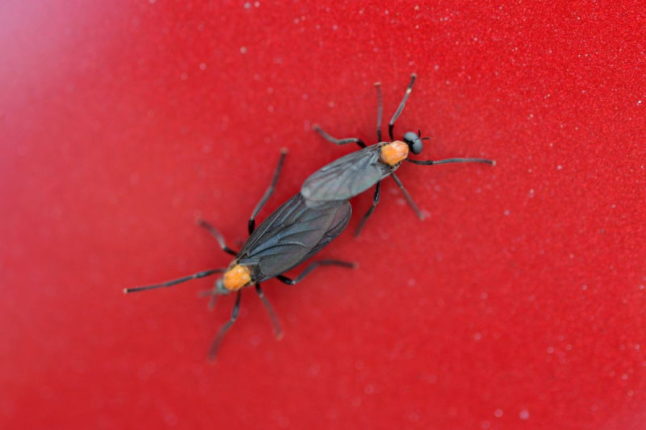
Photo Credit: Florida Fish and Wildlife / Flickr / CC BY-ND 2.0
FAQ About Bugs That Bite and Sting
There are many bugs that don’t bite or sting in Orlando, but the most famous is the lovebug. Lovebugs (which are actually flies) do not bite, sting, or transmit diseases. Unfortunately, they make up for their lack of poison in frustration, trips to the car wash, and difficulty driving on the highway.
Since insect bites itch and cause minor swelling, here are a few tips for how to relieve this discomfort.
A few ideas for how to treat an itchy bite:
• Hydrocortisone cream
• Baking soda paste
• An over-the-counter allergy medicine (check the label for appropriate ages and dosing)
• Ice cube in a moist washcloth
• Calamine lotion
Which insects cause itchy bites?: Bed bugs, chiggers, fleas, mosquitoes
A few ideas for how to treat a painful bite:
• Ice cube in a moist washcloth
• Baking soda solution: Place on the bite for 15-20 minutes
• Over-the-counter pain reliever
Which insects cause painful bites?: Blister beetles, centipedes, deer flies, fire ants, gnats, horseflies
Note: This advice is for educational purposes only. If you have difficulty breathing or swallowing, seek medical help immediately, as this may be an indication of an allergic reaction. Also, if you have any concerns about infection, how to identify the bite, pain, and so on, use your judgment and consider seeking medical attention.
(Information taken from: Tree House Pediatrics: Insect Bite)
We’ve already mentioned the major ways to get rid of mosquitoes in your yard, but here are a few other natural ideas:
• Dethatch: Just as you want to clear out debris from on top of your lawn, dethatching clears out old stems and organic matter between the grass and soil surface. This helps water to reach the soil surface and drain instead of being trapped in the above-soil layer. This means less standing water in the lawn, which means fewer mosquitoes.
• Build a rain garden as a solution to standing water in the lawn.
• Install mosquito-repelling plants, such as bee balm, lavender, and catnip.
If bugs that bite and sting are worse for you than traffic and humidity in Orlando, we can help. Contact one of LawnStarter’s Orlando pest control pros to take the sting out of your life and lawn.
Main photo credit: Egor Kamelev / Pexels
